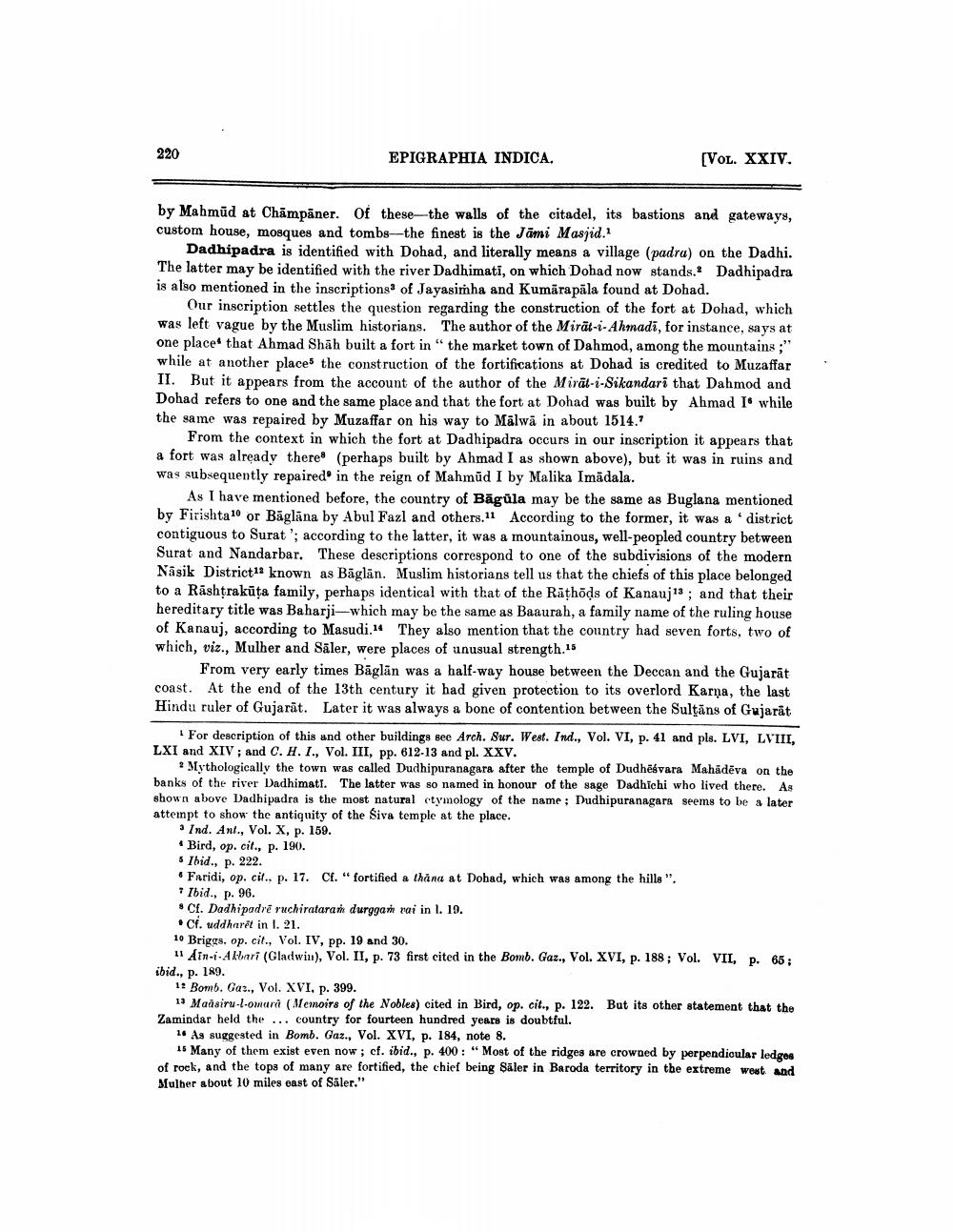________________
220
EPIGRAPHIA INDICA.
(VOL. XXIV.
by Mahmūd at Chāmpāner. Of these-the walls of the citadel, its bastions and gateways, custom house, mosques and tombs-the finest is the Jāmi Masjid.?
Dadhipadra is identified with Dohad, and literally means a village (padra) on the Dadhi. The latter may be identified with the river Dadhimati, on which Dohad now stands. Dadhipadra is also mentioned in the inscriptions of Jayasimha and Kumārapāla found at Dohad.
Our inscription settles the question regarding the construction of the fort at Dohad, which was left vague by the Muslim historians. The author of the Mirät-i-Ahmadi, for instance, says at one place that Ahmad Shāh built a fort in the market town of Dahmod, among the mountains ;" while at another places the construction of the fortifications at Dohad is credited to Muzaffar II. But it appears from the account of the author of the Mivät-i-Sikandarī that Dahmod and Dohad refers to one and the same place and that the fort at Dohad was built by Ahmad I. while the same was repaired by Muzaffar on his way to Malwa in about 1514.7
From the context in which the fort at Dadhipadra occurs in our inscription it appears that a fort was already there (perhaps built by Ahmad I as shown above), but it was in ruins and was subsequently repaired in the reign of Mahmud I by Malika Imädala.
As I have mentioned before, the country of Bāgūla may be the same as Buglana mentioned by Firishta10 or Bāglāna by Abul Fazl and others.11 According to the former, it was a district contiguous to Surat '; according to the latter, it was a mountainous, well-peopled country between Surat and Nandarbar. These descriptions correspond to one of the subdivisions of the modern Nasik District 12 known as Bäglän. Muslim historians tell us that the chiefs of this place belonged to a Rashtrakūta family, perhaps identical with that of the Rathods of Kanauj; and that their hereditary title was Baharji-which may be the same as Baaurah, a family name of the ruling house of Kanauj, according to Masudi. They also mention that the country had seven forts, two of which, viz., Mulher and Säler, were places of unusual strength.15
From very early times Bäglān was a half-way house between the Deccan and the Gujarat coast. At the end of the 13th century it had given protection to its overlord Karņa, the last Hindu ruler of Gujarat. Later it was always a bone of contention between the Sultāns of Gujarat
For description of this and other buildings see Arch. Sur. West. Ind., Vol. VI, p. 41 and pls. LVI, LVIII, LXI and XIV; and C. H. I., Vol. III, pp. 612-13 and pl. XXV.
+ Mythologically the town was called Dudhipuranagara after the temple of Dudhēsvara Mahādēva on the banks of the river Dadhimatt. The latter was so named in honour of the sage Dadhichi who lived there. As shown above Dadhipadra is the most natural etymology of the name : Dudhipuranagara seems to be a later attempt to show the antiquity of the Siva temple at the place.
• Ind. Ant., Vol. X, p. 159. • Bird, op. cit., p. 190.
Ibid., p. 222. * Faridi, op. cit.. p. 17. Cf." fortified a thana at Dohad, which was among the hills". * Ibid., p. 96. • Cf. Dadhipadrē ruchirataram durggan rai in l. 19. . Cf. uddharēt in 1. 21. 10 Briggs, op. cit., Vol. IV, pp. 19 and 30.
11 Ain-i-Alari (Gladwin), Vol. II, p. 73 first cited in the Bomb. Gaz., Vol. XVI, p. 188; Vol. VII, p. 65; ibid., p. 189.
1: Bomb. Gaz., Vol. XVI, p. 399.
11 Maasiru-l-omara (Memoirs of the Nobles) cited in Bird, op. cit., p. 122. But its other statement that the Zamindar held the ... country for fourteen hundred years is doubtful.
16 As suggested in Bomb. Gaz., Vol. XVI, p. 184, note 8.
15 Many of them exist even now; cf. ibid., p. 400: " Most of the ridges are crowned by perpendicular ledgos of rock, and the tops of many are fortified, the chief being Sāler in Baroda territory in the extreme west and Mulber about 10 miles east of Säler."




